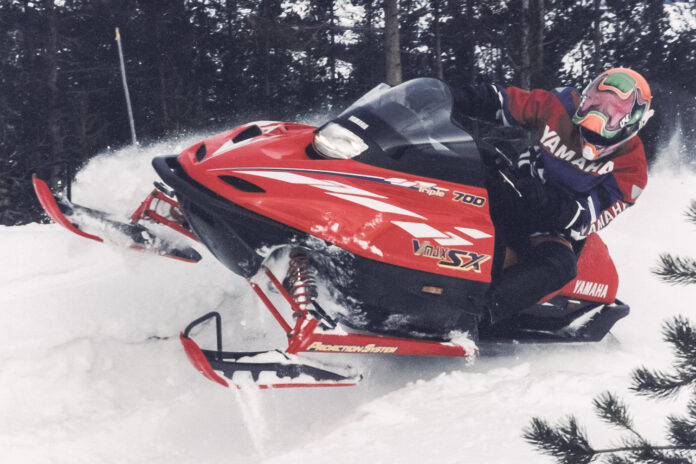Online editor, Mike Lester, challenged me to do a couple reviews on definitively historical and otherwise ground-breaking Yamaha sleds.
Such a challenge always interests me as the younger guys around here need to be reminded of this adage: “Those who forget the past are destined to repeat it”. Actually, that isn’t the actual interpretation of this noteworthy adage, but it does suit my purposes for this article.
THIS CHANGES EVERYTHING!
The arrival of the 1997 Yamaha Vmax 700SX was among the most highly anticipated events in the sport at that time. Why? Everyone absolutely knew Yamaha could not continue to produce sleds with its TSS (Telescopic Strut Suspension) and be taken seriously. Almost 20 years had passed since Polaris brought its Indy trailing arm system to the market and at this time in sno-mo-history the Roseau sled-builder was slaying the market selling a rumored 100,00 new units annually.
The arrival of the all-new Vmax met the market head on directly at its sweet spot. The snowmobile business was consumed with triple cylinder 2-stroke engines. The Indy 650 and Indy XLT 600 triples captured the imagination of a jillion buyers. Yamaha was now legitimately in the game, albeit a couple years late.
Not to worry. The Yamaha faithful gobbled up their Vmax 700’s in record numbers and the sled did not disappoint. Using an all-new, purpose-built triple cylinder, single pipe, reed valve inducted, 120-degree firing mill opened the door on something missing in Yamaha showrooms: The national anthem of snowmobiling spilling out the SX 700’s melodious pipe.
Add in this reality: The 700 triple would go on to become known as one of the most reliable and bulletproof snowmobile engines of the modern era.
SILKY SMOOTH
The 700SX triple put out what is widely reported to be a silky 110-115 ponies. Using proprietary Yamaha primary and secondary clutches and what felt like a low friction drive system spinning a 121-inch track, the sled could pull just past (an indicated) 100 MPH (160 KMH) on Kevlar Lake. The sled was truly competitive to the Polaris triple cylinder fleet and as a result made no excuses for its linear spread of power.
Equally important to the success of the Vmax 700 SX was the presence of a full-on trailing arm independent front suspension (IFS). No more TSS. The market and Yamaha dealers went ape over the sled’s arrival with mainstream IFS. Yamaha coined the set-up “Pro Action Plus” IFS and it looked awfully familiar. Clearly Yamaha was benchmarking Polaris’s Indy IFS.
The SX came with premium aluminum body coil-overs up front and as a result the sled handled well and took bumps in stride. One issue we found interesting was Yamaha’s reluctance to duplicate their version of Polaris’s “tipped in” trailing arm design using unequal length upper and lower radius rods. This nuanced trick helped trailing arm Indys so equipped to handle better on-center and generate less bump steer. The Yamaha used equal length radius rods.
TO COUPLE OR NOT TO COUPLE
Out back the SX 700 brought Yamaha’s proven 121-inch rear skid to the party with a notable change. The entire industry was tied up in a legal jackpot with Polaris surrounding its patent on rear suspension coupling. Polaris would eventually settle the lawsuits and Yamaha would openly disclose the SX rear suspension’s tandem pull rods (debuted on the SX 700) acting on the rear swingarm drop link was a form of coupling as well.
Settlement dollar figures were never made public but suffice it to say Polaris did alright on this deal which included a license to Ski-Doo’s proprietary RER engine reverse system.
The coupled skidframe on the 700 SX gave Yamaha seriously legitimate big bump control and compliance (for that time). As a result, the sled garnered acceptance with hardcore ditch bangers of the era.
LEGITIMATELY ICONIC
So, there you have my opinion and observations on a sled that changed the course of Yamaha’s snowmobile fortunes. The SX marked the end of TSS and a new beginning for Yamaha snowmobile chassis and suspension design.




